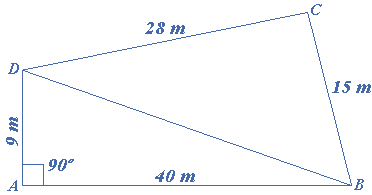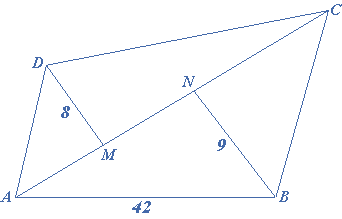The Area of any Irregular Quadrilateral
A plane figure bounded by four straight line segments is called an irregular quadrilateral. The area of any irregular quadrilateral can be calculated by dividing it into triangles.
Example:
Find the area of a quadrilateral $$ABCD$$ whose sides are $$9$$ m, $$40$$ m, $$28$$ m and $$15$$ m respectively and the angle between the first two sides is a right angle.
Solution:

From the figure we notice that $$ABD$$ is a right-angled triangle, in which $$AB = 40$$ m, $$AD = 9$$ m. Also
\[\begin{gathered} B{D^2} = A{B^2} + A{D^2} \\ B{D^2} = {40^2} + {9^2} \\ BD = \sqrt {{{40}^2} + {9^2}} = \sqrt {1681} = 41 \\ \end{gathered} \]
Now, the area of $$\Delta ABD = \frac{1}{2} \times 40 \times 9 = 180$$ m
In $$\Delta BCD$$, $$BD = a = 41$$ m, $$DC = b = 28$$ m, $$CB = c = 15$$ m
$$\therefore s = \frac{{a + b + c}}{2} = \frac{{41 + 28 + 15}}{2} = 42$$ m
Now,
\[\begin{gathered} {\text{Area}}\,{\text{of}}\,\Delta BCD = \sqrt {s(s – a)(s – b)(s – c)} \, \\ {\text{Area}}\,{\text{of}}\,\Delta BCD = \sqrt {42(42 – 41)(42 – 28)(42 – 15)} = \sqrt {42 \times 14 \times 27} = 126\,sq\,m \\ \end{gathered} \]
The area of the quadrilateral $$ABCD$$$$ = $$ area of $$\Delta ABD$$ $$ + $$area of $$\Delta BCD$$
The area of the quadrilateral $$ABCD$$ $$ = (180 + 126) = 306$$ square meters.
Example:
In a quadrilateral the diagonal is $$42$$ cm and the two perpendiculars on it from the other vertices are $$8$$ cm and $$9$$ cm respectively. Find the area of the quadrilateral.

Solution:
Given that from the figure $$AC = 42$$ m, $$BN = 9$$ m, $$DM = 8$$ m
The area of $$ABCD = $$ area of $$\Delta ABC + $$area of $$\Delta ACD$$
The area of $$ABCD$$$$ = \frac{1}{2} \times 9 \times 42 + \frac{1}{2} \times 8 \times 42 = 189 + 168 = 357$$ square meters.

D . N. SAMANTA
July 12 @ 4:35 pm
Very good & very easy solution
K. Gomathi
September 23 @ 7:48 pm
Very easy to understand. But if the angle not known and only four sides are given. How to calculate
HHA
September 14 @ 6:11 pm
That’s how they calculated the area of other triangle.
praful
March 6 @ 10:04 am
no, what if BN ans DM is not known?
Nazim Laskar
February 12 @ 10:00 am
Sir, will you please tell me what is the area of a quadrilater i.e. side AB=20’4″ BC=66’6″ CD=29′ DA=50′. In this angle ABC is 90 degree.
Sanjay Shyoran
September 8 @ 5:57 pm
Sir my plot size is from South to north one west side is 198 ft and other east is 205.6 ft and from east to west from South side is 82.6ft and north side is 27.6 ft.There are 5 brothers.How to divide each share.plz solve this issue.Thanks.
Batraju Naga venkata Chaitanya
October 6 @ 6:08 pm
For example if a chooses the constructing structure
It’s measurements of sides
8m width
8.5m width.
9 m length
9.3 m length
Here cross line is not available for measuring
How to calculate
Mrs.KALAISELVI
October 29 @ 4:08 pm
Sir my plot is quadrilateral shape – total size land is 2513.58 feet . Side A=52 feet , Side B=61 feet, Side C=56 Feet and Side D=35 feet ( Side A facing road , Side B left side, Side C parallel to road and Side D right hand side). There are 2 children’s, how to divide two halves. Please give correct measures into two halves to solve this issue, by way of two method (1) horizontal and 2) straight way) and give correct feet size.
Arasan
August 25 @ 11:50 pm
Hav u got idea to split 2 part
Mithun Mitra
October 30 @ 3:47 am
I have purchased a land of irregular side. What will be the area of the sides are 65 feets, 105 feets, 82 feets and 92 feets.
Swaroop Pyla
August 30 @ 10:16 am
Can you please give the sides lengths as based on the directions, like for example on east = x, west = y, south = a, north = b. It’ll be better if you’ve a diagonal otherwise no problem we can find it out.
RAJESH KUMAR
November 19 @ 3:30 pm
WE HAVE A FIELD (KHET) WHICH SHAPE LIKE IRREGULAR Quadrilateral (LONG- SIDE-1 is 90 AND SIDE-2 is 100 & (WIDTH- SIDE-1 is 10 AND SIDE-2 is 30) HOW TO DIVIDE IN 2 PART OF THIS IN BOTH SIDE (LONG-2 & WIDTH-2)
PLS SUGGEST AND GIVE FORMULA
Ramesh
January 12 @ 7:49 pm
Sir, I need the Area in acres of an irregular quadrilateral measures given below..
North side – 450 feets
South side – 340 feets
East side – 380 feets
West side- 480 feets
Swaroop Pyla
August 30 @ 10:41 am
Area would be 167009.13 Sft = 15515.50 Sq.Mts = 18556.50 Sq.Yds
Nehal
January 13 @ 8:56 pm
How will apply your formula on a square 400 fts each side and a rhombus of same length
R Ravi
February 6 @ 3:43 pm
My plot sizes are as follows:-
Eastern side from North to South 59 feet
Western side from North to south 62.5 feet
Northern side from East to west 31 feet
Southern side from East to west 40 feet
There is 7 feet ply on the North East side
I want to know how to calculate the area of my site please
hapsa
April 9 @ 5:14 pm
my plot size is 30 meters by 29 by 17 by 12 meters. how can i get the total area?
Deepak
May 9 @ 12:29 pm
Sir my plot having four sides of 45, 27, 30, 31 meters respectively. Please help me to calculate the area and deviding this into 6 people…pls sir kindly divide.
RANVIR SINGH
June 15 @ 10:13 am
Respected sir/madam I want to calculate the area of my plots no. sides are 41.5833 feet, 44.5 feet, 41.8333 feet, 44.75 feet
mohammed ali
June 21 @ 12:27 pm
Area of ΔBCD = √42(42–41)(42–28)(42–15)=√42×14×27=126 sqm ????
CAN YOU PLEASE EXPLAIN THIS
Vipan Aggarwal
September 5 @ 9:31 pm
My plot’s sides are 19.33ft, 17.0ft, 43.58 ft and 45.66 ft. What will be the area of my plot
Humberto Alarcón
October 15 @ 3:56 am
How can we find the diagonal length if it’s not given and no right angles….??
North = 12.05m
West = 8.00m
South = 15.00m
East = 10.17m
Ma.socorro tagamolila
March 4 @ 7:02 pm
Northeast 22.31 meters,northwest 25.03 meters, southwest 24.55 meters,southeast 25.61 meters
Gary
June 10 @ 8:18 pm
In your first example of quadrilateral with sides of 9,40, 28 and 15, ABD is 180 sq meters but no chance that BCD is 126…it is at least 210 sq meters…..
benard w
October 4 @ 8:40 pm
Hello sir, I have a piece of land with theses sides: north-72metres, south-72metres, east-25metres, west-12metres. Can you help me calculate the total area of this plot?
Amol
January 8 @ 7:55 pm
My plot is 171.5 by 164 feet and 34.3 by 33.3. What is the area?
Islam Eldeeb
March 20 @ 2:50 pm
North 528.54
South 9.74
East 875.56
West 708.06
Please calculate the area of this project.
Islam Eldeeb
March 20 @ 2:56 pm
North 528.54 Meter
South 9.74 Meter
East 875.56 Meter
West 708.06 Meter
what will be the area in m2
Ghazane
March 31 @ 3:04 pm
Need the area of
46ft
151ft
224 ft
300 ft
Karan Singla
April 25 @ 7:04 pm
South side 55inch north side 63 inch. East side 83.33 inch and west side 57.8. Find the area..
P R Wray
August 27 @ 5:27 pm
In the diagram above you have the figure 42 as the length of AB, not as the length of AC.
shashikant
January 26 @ 12:28 pm
East 202 feet
west 218 feet
South 96 feet
North 102 feet
Square feet and Gunte?